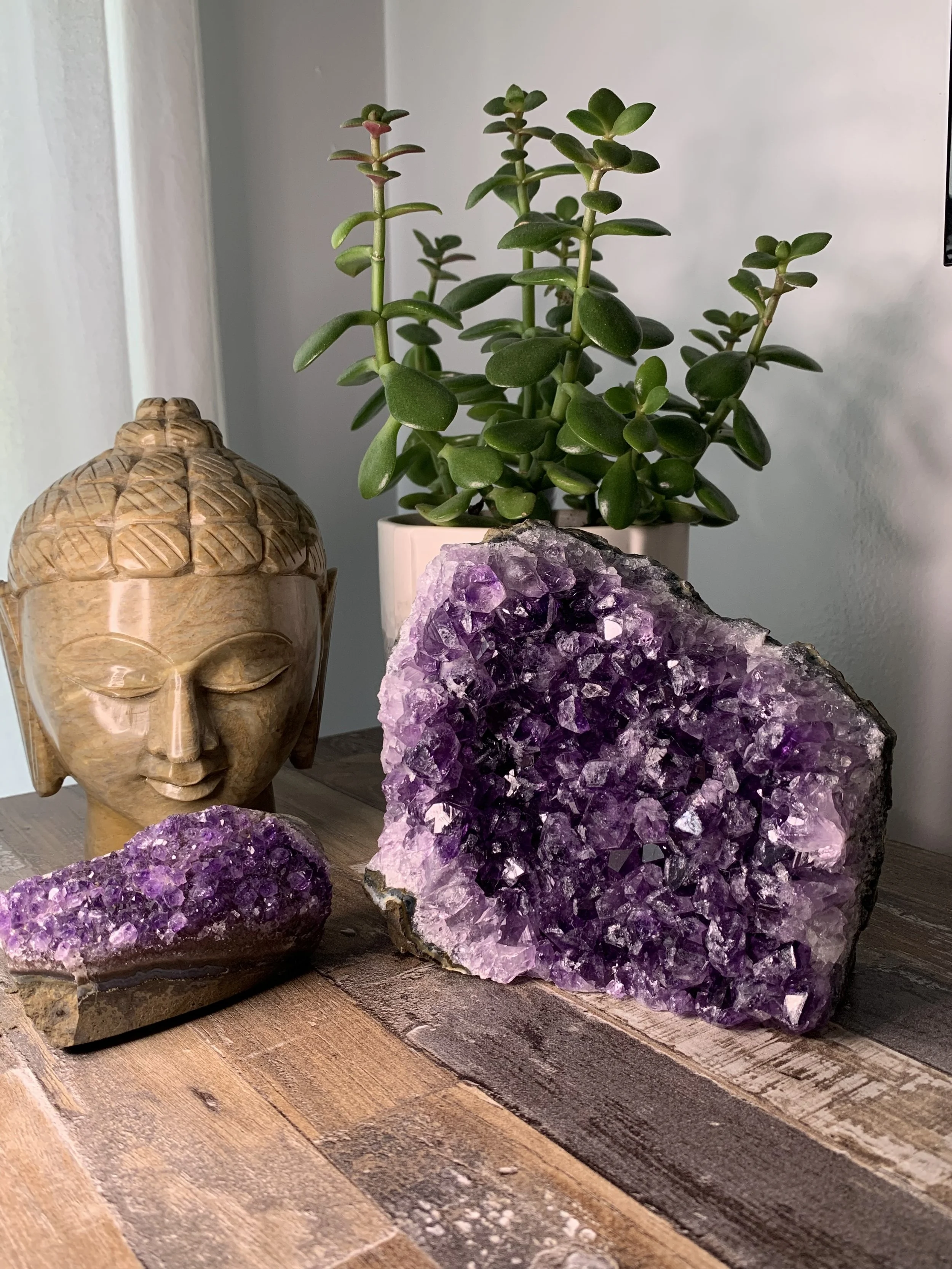Amethyst
Amethyst, with its captivating shades of purple, is a gemstone that has inspired human imagination for thousands of years. This stunning crystal is not only a feast for the eyes but also has a rich history, fascinating mythology, and various uses that make it a favorite among crystal enthusiasts and jewelry lovers alike.
A Glimpse into History
The name "amethyst" originates from the Greek word "amethystos," meaning "not intoxicated." Ancient Greeks believed this mesmerizing stone could prevent drunkenness and wore it as a talisman to protect against overindulgence. Goblets carved from amethyst were popular among the elite, who hoped to stay clear-headed while enjoying their wine.
In ancient Egypt, amethyst was used as a protective amulet and was often buried with the dead to ensure a safe passage to the afterlife. The crystal was also highly valued by the Romans, who used it in engraved gems and cameos. Throughout history, amethyst has been linked to various deities and spiritual figures, including Bacchus, the Greek god of wine, and Saint Valentine, the patron saint of love.
According to Greek mythology, amethyst’s beautiful color is said to be due to the wine god Dionysus. The story goes that Dionysus, angry at a mortal, vowed to unleash his tigers on the first person he encountered. That unfortunate individual was a maiden named Amethyst. She prayed to the goddess Artemis for protection, and Artemis turned her into a statue of pure quartz. When Dionysus saw this, he felt remorse and poured his wine over the statue, staining it the royal purple we see today.
Healing Properties and Uses
Amethyst is renowned not only for its beauty but also for its supposed healing qualities. It's commonly linked to calmness, mental clarity, and spiritual growth. Amethyst is believed to assist in the following ways:
Promote calmness: Its calming energy is thought to help reduce stress and anxiety.
Enhance intuition: Many spiritual practitioners use amethyst to deepen their meditation and connect with their intuition.
Protect against negativity: Amethyst is often used as a protective stone to ward off negative energy and psychic attacks.
Amethyst is recognized for its strong spiritual qualities, which are thought to strengthen one's connection to the divine and encourage spiritual growth. Some of the main spiritual qualities of amethyst include:
1. Protection
Amethyst is widely known as a protective stone. It is believed to create a shield of spiritual light around the aura, warding off negative energies and psychic attacks. This protective quality makes amethyst a popular choice for those who practice spiritual activities such as meditation and energy healing.
2. Purification
Amethyst is recognized for its ability to purify and cleanse the mind, body, and spirit. It is often used to eliminate negative energies and foster a sense of inner peace and tranquility. Many people use amethyst to cleanse their living spaces by placing the crystal in key areas to maintain a harmonious and balanced environment.
3. Intuition and Insight
One of the most valued spiritual properties of amethyst is its ability to boost intuition and psychic abilities. It is believed to open the third eye chakra, which is connected to intuition and spiritual awareness. By stimulating the third eye, amethyst can help individuals receive insights, visions, and messages from higher realms.
4. Meditation and Spiritual Awareness
Amethyst is a favored crystal for meditation because of its calming and centering energy. It is believed to enhance spiritual awareness and promote a deep meditative state. Meditating with amethyst can help individuals connect with their higher selves, access inner wisdom, and attain a sense of spiritual enlightenment.
5. Emotional Healing and Balance
Amethyst is also known for its capacity to promote emotional healing and stability. It is believed to soothe the mind and calm the emotions, making it an excellent stone for those dealing with stress, anxiety, or grief. By encouraging emotional stability, amethyst can help individuals achieve inner harmony and well-being.
Fun Facts About Amethyst
· Amethyst is the birthstone for February, making it a perfect gift for those born in this month.
· In ancient times, amethyst was regarded as one of the most valuable gemstones, even more precious than diamonds.
· The largest amethyst geode in the world, known as the "Empress of Uruguay," stands at an impressive 11 feet tall and weighs over 2.5 tons.
Today, amethyst is a popular choice for all kinds of jewelry, from rings to necklaces to earrings. Its versatile shades of purple complement various metals and settings, making it a cherished gemstone for both casual and formal wear. Beyond jewelry, amethyst also has a place in home décor. Large amethyst geodes or clusters serve as eye-catching centerpieces and are believed to create a calming atmosphere in any room. Smaller amethyst crystals can be placed under pillows or on nightstands to encourage restful sleep and sweet dreams.
Amethyst is a gemstone that combines stunning beauty with a fascinating history and many uses. Whether you're attracted to it for its appearance, its purported healing properties, or its rich cultural significance, amethyst is truly a gem worth appreciating. So why not bring a touch of purple tranquility into your life with this enchanting crystal.
Curious to learn more? If you haven’t already, join my newsletter for free insights delivered straight to your inbox. We’ll update you whenever a new article or video is published! And did we mention–it’s free?
Plus, all new subscribers get a free copy of my E-Book: Red Flag, Green Flag: A Rookie’s Guidebook to Digital Discernment. You won’t want to miss this one. I cover all the ways to spot the real deals from the fakes as you navigate your spiritual journey!
~ Noel (Spiritual Rookies)

